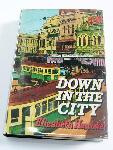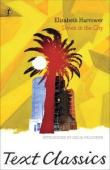AustLit
Latest Issues
AbstractHistoryArchive Description
Contents
- Introduction, essay
Publication Details of Only Known VersionEarliest 2 Known Versions of
Other Formats
- Sound recording.
Works about this Work
-
Moments of Being in the Fiction of Elizabeth Harrower
2017
single work
criticism
— Appears in: Elizabeth Harrower : Critical Essays 2017; (p. 137-148) 'In her poetic catalogues of being and experience, Emily Dickinson records the chasm between the visibility of the world, including the poetic image, and the invisibility of inner transformation. In one such poem she writes: “We can find no scar / But internal difference – / Where the Meanings, Are –”. Elizabeth Harrower’s fiction investigates this “internal difference” in both its invisibile [sic] and its hypervisible effects, and understood in the related senses of transformation, individuation and self-division. In these representations, Harrower deploys a very particular version of the modernist epiphany or moment of being. In her novels and short stories this epiphany characteristically interweaves and disentangles the subjects and objects of the narratives. One recurring revelation exposes the ways some human subjects wire themselves and others through the objects of postwar consumer culture to expose how (mostly) women can become relegated to object status in and through these dynamics. In another mode, Harrrower’s narratives record moments of instant, electrical connection between strangers, who are otherwise isolated. Across the spectrum of these interactions, as this essay will investigate, the revelations experienced by Harrower’s characters are always intersubjective – even if the ultimate revelation is solitary and about the condition of being solitary in the world. This essay will identify at least some of the key properties of Harrower’s epiphanies and consider how they relate to narrative mode and genre by moving between her short fiction and the novels. Ranging across these different genres, in view of their respective relationships to realism and their capacities to represent temporality and causality, underscores the operations of her particular postwar, postmodern epiphany and its centrality to her understanding of being in the world.' (Introduction) -
Weather and Temperature, the Will to Power, and the Female Subject in Harrower's Fiction
2017
single work
criticism
— Appears in: Elizabeth Harrower : Critical Essays 2017; (p. 71-85)'The opening sentence of the first short story Elizabeth Harrower ever completed 3 plunges the reader into a dramatic meteorological event:
And then, as if the lightning that ripped the sky apart wasn’t enough, the lights round the edge of the swimming pool, and even the three big ones sunk into it on cement piles, went out. At once the solid blackness rang with shrieks and laughter; only Janet was struck dumb to find that she had been obliterated. It was like nothing so much as that astronomical darkness into which she had been plunged last year when they took out her tonsils. (Introduction)
-
'The Wind from Siberia' : Metageography and Ironic Nationality in the Novels of Elizabeth Harrower
2017
single work
criticism
— Appears in: Elizabeth Harrower : Critical Essays 2017; (p. 54-70)'Elizabeth Harrower’s third novel, The Catherine Wheel (1960) – the only one set outside Australia – begins with an example of what Jon Hegglund terms modernist “metageography”: that is, a use of maps and the conventions of cartographic representation in such a way as to defamiliarise the social production of space, and of national and personal identity. 1 Clemency James, a young Australian woman, has come to London in the late 1950s to study for the bar, and as she returns to her bedsitting room from a shopping trip to Notting Hill Gate, she takes her bearings from a weather report that locates London in relation to the landmass of hemispheric Europe:
“The wind from Siberia as announced by the BBC came down Bayswater Road from the direction of Marble Arch somewhere in a straight line beyond which, half a world away, Siberia was taken to be”. 2 Zooming in to a local scale, Clem locates her “centre of the universe” (3) in a boarding house just off Bayswater Road: Across the road the enigmatic façades of a row of semi-public buildings ended where the railings of Kensington Gardens began. Just opposite this corner of the gardens Miss Evans had her service-house, and it was here I had a room with a diagonal view of bare black avenues and paths and empty seats and grass. (4)' (Introduction)
-
A Wrong Way of Being Right : The Tormented Force of the Harrower Man
2017
single work
criticism
— Appears in: Elizabeth Harrower : Critical Essays 2017; (p. 38-53) 'Elizabeth Harrower’s fictions are often severe and enigmatic, and, although riveting in their surface action and exquisite in their style, do not immediately disclose their meaning. Yet it could well be said that if Harrower has a subject it is gender. All her novels are about gender relations and hierarchies. Indeed, the only way to ignore this is if we persist in seeing gender as a minor and provincial sphere, not heeding to the way that, as Raewyn Connell puts it, gender institutions affect all social institutions. This is even more salient as we realise how, in Connell’s words, gender differences can appear in one sense so “stark and rigid” and in another so “fluid, complex, and uncertain”.' (Introduction) -
Sydney in the Fiction of Elizabeth Harrower
2017
single work
criticism
— Appears in: Elizabeth Harrower : Critical Essays 2017; (p. 28-37) 'The recent publication by Text of two new works by Elizabeth Harrower, along with their reissuing of all her earlier novels, some out of print for over fifty years, provides an ideal opportunity to study the development of various themes and preoccupations in her fiction. I have chosen here to focus on her fictional representations of Australia and Australians, and in particular how the city of Sydney, where she has spent most of her life, figures in her work. The previous difficulty of accessing Harrower’s novels has, no doubt, been one of the reasons why they have received little detailed critical study. Most essays published to date have discussed The Watch Tower (1966), using a variety of perspectives but rarely mentioning its Sydney setting. In 1990, when editor of Southerly, I published an essay on Down in the City (1957) by Rosie Yeo, based on her Honours thesis which I had supervised, to draw attention to this then largely forgotten novel. While the differences in class and attitude of those who live in various parts of Sydney are especially important in this novel, the city appears in all of Harrower’s works, even those not primarily set there.' (Introduction)
-
[Review] Down in the City
1957
single work
review
— Appears in: The Sydney Morning Herald , 19 October 1957; (p. 13)
— Review of Down in the City 1957 single work novel -
[Review] Down in the City
1957
single work
review
— Appears in: The Times Literary Supplement , 2 August 1957; (p. 496)
— Review of Down in the City 1957 single work novel -
Reviewed Briefly
1958
single work
review
— Appears in: The Bulletin , 1 January vol. 79 no. 4064 1958; (p. 59)
— Review of Down in the City 1957 single work novel -
[Review] Down in the City
1980
single work
review
— Appears in: Westerly , September vol. 25 no. 3 1980; (p. 109-112)
— Review of Down in the City 1957 single work novel -
Nightmares in Dream Homes
2013
single work
review
— Appears in: The Weekend Australian , 2-3 November 2013; (p. 23)
— Review of Down in the City 1957 single work novel -
Australian Literature : Elizabeth Harrower
2012
single work
column
— Appears in: The Sun-Herald , 6 May 2012; (p. 18-19) 'Gay Alcorn talks to Elizabeth Harrower, who was one of the country's most celebrated author's until she stopped writing 40 years ago.' -
Written in the Past Tense
2012
single work
column
— Appears in: The Sunday Age , 6 May 2012; (p. 15) Gay Alcorn reports on the first interview with Elizabeth Harrower in more than two decades. -
Culture in Australia - The Year's Clip
1958
single work
criticism
— Appears in: Current Affairs Bulletin , 15 December vol. 23 no. 4 1958; (p. 51-64) -
Out of Print, Out of Mind
1988
single work
criticism
— Appears in: The Sydney Morning Herald , 3 December 1988; (p. 88) Real Opinions : Polemical and Popular Writings 1992; (p. 145-147) -
The Active Passive Inversion : Sex Roles in Garner, Stead and Harrower
1986
single work
criticism
— Appears in: Meanjin , Spring vol. 45 no. 3 1986; (p. 346-353)' Five novels by Australian women novelists, namely Christina Stead's 'For Love Alone' (1945), Helen Garner's 'Monkey Grip' (1977) and Elizabeth Harrower's 'Down in the City' (1957), 'The Catherine Wheel' (1960) and 'The Watch Tower' (1966) are critically analysed to explore the reversal of gender roles in them. It is suggested that the women in the novels attend to their men's needs and problems by performing an active role in a passive manner, while the males are actually passive within their active appearances.' (Publication abstract)
- Sydney, New South Wales,





